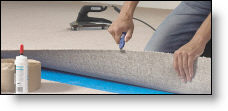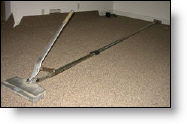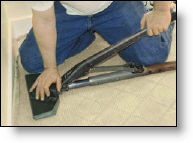Carpet installation
Purchasing a carpet for your home can be quite an investment and installing carpet requires specialized skills and tools. For this reason it is a good idea to pay attention to tested and working carpet installation techniques and tips. This page introduces
carpet installation tips that have been tested through many years of carpet installation experience.
Preparing for carpet installation
A quality carpet installation is critical to the performance of the carpet, and the preparation for your carpet installation starts even before either the carpet installer or other aides arrive. The following is a list of activities that need to be done as a preparation for carpet installation.

- Remove furniture: First, remove all furniture and everything that is hanging over the carpet such as curtains.
- Vacuum: The second step in carpet installation is to vacuum the old carpet. This will help to eliminate dust and dirt.
- Hide valuables:In case you keep any valuables in your room, it is very wise to hide them away for the time of the carpet installation works.
- Ventilation: Provide good ventilation (open windows) to dilute fumes from carpet installation chemicals.
- Remove the old carpet: Remove the old carpet and put it away for ecologic disposal.
- Vacuum: You have already vacuumed the room once, but now you need to vacuum it again to remove all debris from underneath the carpet and from the carpet removal.
When the new carpet arrives

When the new carpet for your new carpet installation arrives, you need to check it for proper delivery, quality, and defects. The following is a checklist of activities for this phase of your new
carpet installation process.
- Delivery check: Check the delivered carpet and also the labeling on the carpet to see if the delivered carpet matches your purchase. Compare them to your sales receipt or invoice and also to the warranty documentation. Keep the label, sales receipt, and warranty for your records.
- Quality check: Inspect the carpet to be installed for quality. Inspect the carpet backing for defects.
- Communicate: Contact the retailer if any part of your order is incorrect. In case any part of your carpet delivery is incorrect, do not wait, act immediately.
Carpet installation checklist

Now the carpet installation specialist has begun the carpet installation itself. During the carpet installation, check or assure the following:
- Power stretch: Carpet should be power stretched as part of the carpet installation process using a special carpet stretching tool called "carpet stretcher" (see the picture to the left). Power stretching the carpet will help to prevent wrinkles.
- Seams: Make sure the seams are double glued. This will prevent delamination and fuzzing.
- Doors: The carpet installation specialist should also check that doors can accommodate the new carpet and still move freely. Doors may need to be removed, trimmed, and re-hanged.
After the carpet installation
After the new carpet is installed, you are almost done with your carpet installation process. There are only a few actions that you still need to take.
- Vacuum: You need to vacuum again. This time, you need to vacuum loose carpet fibers and any debris that remained after the installation.
- Initial care: Fibers may shed or sprout for a few days after carpet installation is done. Never pull these out. Always clip the sprouts with sharp scissors. Pulling may unravel the fibers and damage the carpet.

When to call the installer to come back
There are a few situations when you should call the installer back. The smell of a new carpet should clear quickly, usually in less than 72 hours. You should contact the installer if the carpet smell does not dissipate after 2 to 3 days of ventilation. Another reason to call the installer back and inquire about your
carpet installation is if the carpet starts wrinkling. It may be necessary to professionally restretch the carpet if ripples on a newly installed carpet occur (see the picture to the right).

 When the new carpet for your new carpet installation arrives, you need to check it for proper delivery, quality, and defects. The following is a checklist of activities for this phase of your new carpet installation process.
When the new carpet for your new carpet installation arrives, you need to check it for proper delivery, quality, and defects. The following is a checklist of activities for this phase of your new carpet installation process.
 Now the carpet installation specialist has begun the carpet installation itself. During the carpet installation, check or assure the following:
Now the carpet installation specialist has begun the carpet installation itself. During the carpet installation, check or assure the following:
